Security Risks Abound at U.S. Chemical Plants
Air Date: Week of March 26, 2004
Forget biological stockpiles and nuclear arsenals. Take a look at the nation’s chemical industry, and you may find that the more than 2,000 manufacturing plants across the country could be the most vulnerable targets for terrorist attack. Reporter Carl Prine of the Pittsburgh Tribune-Review investigated dozens of plants in four major cities, and found numerous security flaws and little government regulation for facilities housing potentially dangerous and toxic chemicals.
Transcript
CURWOOD: Welcome back to Living on Earth, I'm Steve Curwood.
Making chemicals in the U.S. is big business. There are more than 2,000 manufacturing plants nation-wide, and the chemicals brewed in these factories are used in everything from plastics to pesticides. These facilities have been operating for years with little in the way of security regulations. And since September 11th, some people worry that stockpiles at these plants could be turned into weapons for terrorists.
Carl Prine is a reporter with the Pittsburgh Tribune-Review, who tested the security of these chemical plants first-hand. Along with a camera crew from 60 Minutes, Mr. Prine took stock of dozens of chemical plants in four major U.S. cities. He reported his findings in a multi-part series for his newspaper. Carl Prine, welcome to Living on Earth.
PRINE: Hello.
CURWOOD: Tell me, what kind of chemicals, what kind of industrial chemicals do we have here in America, just briefly?
PRINE: Well, there are hundreds of very toxic chemicals that EPA regulates. The ones that are particularly dangerous are chlorine gas, phosgene, methylisocyanide – chemicals that actually have been used in the past as weapons in warfare.
CURWOOD: Now, how could one weaponize chemicals out of America’s industrialized plants?
PRINE: Well, sometimes it’s as simple as blowing a hole in the containment vessel. If you do that you’ll release a weapon of mass destruction.
CURWOOD: And what else might someone do?
PRINE: Well, there are other ways you could do it. You could try different reactive chemicals to set up a reactive process that will blow a containment vessel. Or you can mix certain chemicals in such a way as to create a particularly lethal gas.
Of course, in the past, people worried about terrorists stealing chemicals and then turning them into a weapon -- kind of combining them into a gaseous form and then releasing them. We thought we saw that in Om Shinrikyo’s attacks in Tokyo. But more recently, people believe that Al Queda, particularly -- since it has an interest in sowing mass destruction in a very limited area -- that probably a chemical plant itself would do the trick.
CURWOOD: Now, as I understand it, given the devastating affect that chemicals could have in an area, you and some other investigators decided to see just how easy or hard it might be for somebody who had, say, ill intent to get into a chemical plant with dangerous chemicals. What were some of the plants that you investigated?
PRINE: It ran the gamut. I mean, there were very small manufacturers and storage facilities that nevertheless stored catastrophic amounts of chemicals. And there were also major manufacturers, members of the American Chemistry Council, who have always said that their plants were the safest and that their security was the tightest.
Some of them were large ones, like the Ashland plant here in Pittsburgh, Neville Chemical, which is the one we did with 60 Minutes. But also ones people have probably never heard, like the KIK plant in Houston, which is actually a very small facility but they have enough chlorine on site to affect three million people. And when I say affect, I mean kill, injure, or displace.
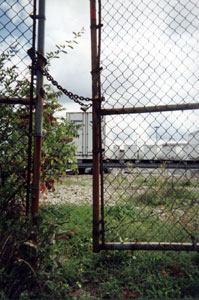 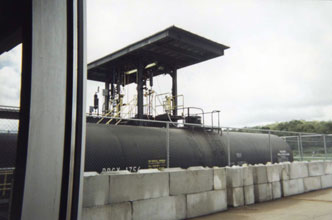 |
||
The Sony plant near Pittsburgh stores large amounts of chlorine gas, enough to kill, injure or displace more than 100,000 people in the suburban stretch of southern Pittsburgh. (Photo courtesy of Tribune-Review)
CURWOOD: Three million people? PRINE: Yes, and those figures are actually created by the industry itself. The idea is that they report to the EPA numbers that they think are likely in a worst case scenario. The idea is to prevent accidents. CURWOOD: What plan of action did you have in approaching each of these sites? I mean, did you sort of have a universal security test?
There was a Sysco plant in Chicago where one of the guards was asleep and I simply walked by. The Patapsco Wastewater Facility in Baltimore was the same way, where they actually had paid for a guard but the guard was sleeping. In fact, at the Chicago plant I actually woke the guard up on my way out and said “goodbye!” And he said “goodbye.’” CURWOOD: Tell me what you saw when you investigated one of these plants. Walk us into, say, Neville Island -- that’s a facility right in your town there of Pittsburgh that you investigated. PRINE: What we did is you simply walk along a rail line, it’s an unpoliced rail line. And you open a gate, or you walk through one of the many open gates, and you’re in. And it’s a very short walk from there to the boron trifluoride. CURWOOD: To the boron trifluoride? PRINE: Boron trifluoride – they use it in a reactive chemical process to make resins, plastic resins and things like that. It’s also been used in the past as an insecticide. So when it kills, it kills people much like it would an insect. CURWOOD: And how toxic is it? PRINE: It’s very toxic. That’s why it’s regulated by EPA. It would act like a gigantic roach motel if you were ever to get near it.
PRINE: There are none. There’s absolutely none – which is the point of a great deal of federal legislation that is going forward from both the Republican and the Democratic sides, to try to shore up shoddy security, years of bad security at chemical plants. CURWOOD: So, in other words, if I wanted to have a million gallons of highly poisonous chlorine gas compressed at my industrial plant, that’s just fine? I don’t have to worry about any regulations as long as it’s in an industrial zone someplace? PRINE: Exactly. And some cities have no zoning. Go to Houston and you’ll find a major petrochemical plant sitting right next to a suburban housing unit. I mean, it’s just the way of life there. Houston was one of the ones we targeted, and that was very scary, where you could simply walk up to a plant and realize that the school next door would be in the pathway of the toxic chemicals if they were released. CURWOOD: So Carl, somebody listening to this, and certainly me – I’m thinking, alright, these plants really sound vulnerable. What evidence has there been that chemical plants could, in fact, be likely terrorist targets? PRINE: Well, first of all, they have been terrorist targets in the past. There were a couple of white supremacist groups in California and Texas that tried to unleash toxic chemicals. One was propane and the other one, I believe, was chlorine gas. In the war in Croatia in the mid-90s, the Serbs actually targeted with their artillery Croatian chemical plants in an attempt to release it. Most recently in Israel, Israeli authorities are investigating an attack at a port facility there where they believe the suicide bombers were detonating so close to chemical tanks in an effort to release toxic chemicals. And the crazy thing is, we also know that Al Qaeda was targeting chemical plants. We know that Mohammed Atta had looked at a plant in Tennessee. And in the bunkers in Tora Bora and some other parts of Afghanistan, when they were overrun by U.S. troops, they discovered chemical industry plans that the terrorists had been looking at.
|

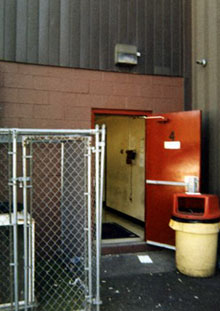 Open doors to warehouses allowed the Pittsburgh Tribune-Review reporter access to dozens of containers storing large amounts of anhydrous ammonia, a dangerous substance that doubles as a coolant, fertilizer and explosive. (Photo courtesy of Tribune-Review)
Open doors to warehouses allowed the Pittsburgh Tribune-Review reporter access to dozens of containers storing large amounts of anhydrous ammonia, a dangerous substance that doubles as a coolant, fertilizer and explosive. (Photo courtesy of Tribune-Review) 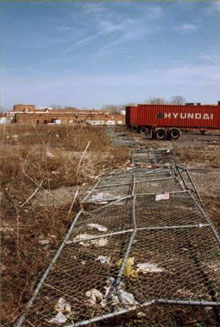 In the Chicago stockyards, dilapidated or broken fences allowed easy access to a number of major refrigeration complexes in the heart of the city. (Photo courtesy of Tribune-Review)
In the Chicago stockyards, dilapidated or broken fences allowed easy access to a number of major refrigeration complexes in the heart of the city. (Photo courtesy of Tribune-Review) 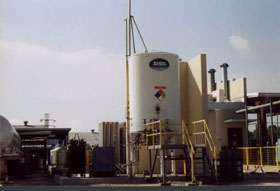 Airgas Specialty Gases in Houston was one of ten plants penetrated by the Tribune in Houston. Airgas stores large amounts of methyl chloride, a highly flammable, explosive gas that, when kindled, produces highly toxic phosgene and hydrogen chloride fumes. (Photo courtesy of Tribune-Review)
Airgas Specialty Gases in Houston was one of ten plants penetrated by the Tribune in Houston. Airgas stores large amounts of methyl chloride, a highly flammable, explosive gas that, when kindled, produces highly toxic phosgene and hydrogen chloride fumes. (Photo courtesy of Tribune-Review) 



